Conquest of Tunis (1535)
The Conquest of Tunis in 1535 was an attack on Tunis, then under the control of the Ottoman Empire, by the Habsburg Empire of Charles V and its allies.
| Conquest of Tunis | |||||||||
|---|---|---|---|---|---|---|---|---|---|
| Part of the Ottoman–Habsburg wars and the Ottoman–Portuguese conflicts | |||||||||
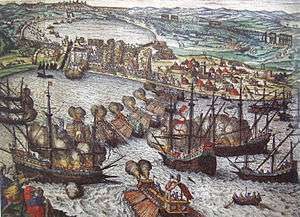 Attack on La Goletta, with Tunis in the background. 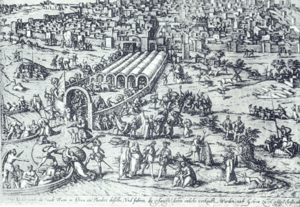 Entry of Charles V, Holy Roman Emperor into Tunis in 1535. | |||||||||
| |||||||||
| Belligerents | |||||||||
|
|
| ||||||||
| Commanders and leaders | |||||||||
|
|
| ||||||||
| Strength | |||||||||
|
Total men: 30,000-60,000
Total ships: 398 |
| ||||||||
| Casualties and losses | |||||||||
| Unknown: Many fell to dysentery |
30,000 Muslim civilians killed 9,000 Christians freed | ||||||||
Background
In 1533, Suleiman the Magnificent ordered Hayreddin Barbarossa, whom he had summoned from Algiers, to build a large war fleet in the arsenal of Constantinople.[6] Altogether 70 galleys were built during the winter of 1533–1534, manned by slave oarsmen, including 2,000 Jewish ones.[7] With this fleet, Barbarossa conducted aggressive raids along the coast of Italy, until he conquered Tunis on 16 August 1534, ousting the local ruler, theretofore subservient to the Spanish, Muley Hasan.[8][9] Barbarossa thus established a strong naval base in Tunis, which could be used for raids in the region, and on nearby Malta.[8]
Charles V, one of the most powerful men in Europe at the time, assembled a large army of some 30,000 soldiers, 74 galleys (rowed by chained Protestants shipped in from Antwerp),[10] and 300 sailing ships, including the carrack Santa Anna and the Portuguese galleon São João Baptista, also known as Botafogo (the most powerful ship in the world at the time, with 366 bronze cannons) to drive the Ottomans from the region.[11] The expense involved for Charles V was considerable, and at 1,000,000 ducats was on par with the cost of Charles' campaign against Suleiman on the Danube.[12] Unexpectedly, the funding of the conquest of Tunis came from the galleons sailing in from the New World, in the form of a 2 million gold ducats treasure extracted by Francisco Pizarro in exchange for his releasing of the Inca king Atahualpa (whom he nevertheless executed on 29 August 1533).[12]
Despite a request by Charles V, Francis I denied French support to the expedition, explaining that he was under a 3-year truce with Barbarossa following the 1533 Ottoman embassy to France.[13] Francis I was also under negotiations with Suleiman the Magnificent for a combined attack on Charles V, following the 1534 Ottoman embassy to France. Francis I only agreed to Pope Paul III's request that no fight between Christians occur during the time of the expedition.[13]
Battle
On 1 June 1535, protected by a Genoese fleet, Charles V destroyed Barbarossa's fleet and, after a costly yet successful siege at La Goletta, captured Tunis. In the action, the Portuguese galleon Botafogo distinguished itself by breaking the chains protecting the harbour's entrance with its spur ram, thereafter opening fire on La Goletta. In the ruins, the Spanish found cannonballs with the French Fleur-de-lys mark, evidence of the contacts stemming from the Franco-Ottoman alliance.[11]
The resulting massacre of the city left an estimated 30,000 dead.[14] Barbarossa managed to flee to Algiers with a troop of several thousand Turks.[4] Muley Hasan was restored to his throne.[4] The stench of the corpses was such that Charles V soon left Tunis and moved his camp to Radès.
The siege demonstrated the power projection of the Habsburg dynasties at the time; Charles V had under his control much of southern Italy, Sicily, Spain, the Americas, Austria, the Netherlands, and lands in Germany. Furthermore, he was Holy Roman Emperor and had de jure control over much of Germany as well.
Ottoman defeat in Tunis motivated the Ottoman Empire to enter into a formal alliance with France against the Habsburg Empire. Ambassador Jean de La Forêt was sent to Constantinople, and for the first time was able to become permanent ambassador at the Ottoman court and to negotiate treaties.[15]
Charles V celebrated a neo-classical triumph "over the infidel" at Rome on April 5, 1536 in commemoration of his victory at Tunis.[16][17][18] The Spanish governor of La Goulette, Luys Peres Varga, fortified the island of Chikly in the lake of Tunis to strengthen the city's defences between 1546 and 1550.
Aftermath
Barbarossa managed to escape to the harbour of Bône, where a fleet was waiting for him. From there, he sailed to accomplish the Sack of Mahon, where he took 6,000 slaves and brought them to Algiers.[19]
The Ottomans recaptured the city in 1574. However the Ottoman governors of Tunis were semi-autonomous Beys who acted as privateers against Christian shipping. Consequently, raiding in the Mediterranean continued until the French subjugated the region as a protectorate three centuries later in 1830 with an invasion leading to the creation of French Algeria, and the establishment of a protectorate over Tunisia in 1881.
Gallery
 Bombardment of La Goletta.
Bombardment of La Goletta. Attack at La Goletta.
Attack at La Goletta. Battle scene at Tunis, 1535.
Battle scene at Tunis, 1535.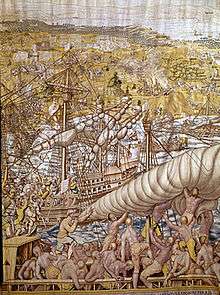 Liberation of 20,000 Christian captives.
Liberation of 20,000 Christian captives. Charles V going to Radès.
Charles V going to Radès.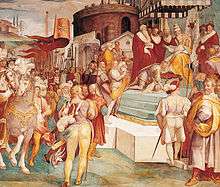 Charles V announcing the capture of Tunis to Pope Paul III in 1535.
Charles V announcing the capture of Tunis to Pope Paul III in 1535.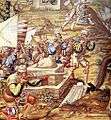 Imperial troops in the conquest of Tunis, 1535, Jan Cornelisz Vermeyen.
Imperial troops in the conquest of Tunis, 1535, Jan Cornelisz Vermeyen.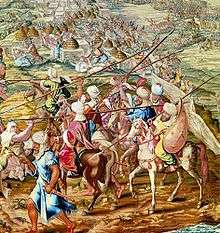 Ottoman troops in the conquest of Tunis, 1535.
Ottoman troops in the conquest of Tunis, 1535.
See also
- Barbary corsairs
- Conquest of Tunis (1574)
- Algiers expedition (1541)
- Siege of Castelnuovo
- Battle of Djerba
- Siege of Malta (1565)
- Battle of Lepanto
- Ottoman–Habsburg wars
- Ottoman–Portuguese conflicts
Notes
- Roger Crowley, Empires of the Sea, faber and faber 2008 p.61
- History of the Ottoman Empire and modern Turkey Ezel Kural Shaw
- 15 galleys of the Mediterranean Squadron, 42 ships of the Cantabrian fleet, 150 ships of the Málaga Squadron
- Crowley, p.61
- Garnier, p.96
- Crowley, p.56
- Crowley, p.57
- Crowley, p.58
- Also known as Muleassen in Italy, and Abu-Abd-Allah-Mohammed-el-Hasan in Tunis. Il Palazzo di Fabrizio Colonna a Mezzocannone, article by Bartolommeo Capasso in Napoli nobilissima: rivista di topografia ed arte napoletana, Volumes 1–3, page 100-104.
- Crowley, p.59
- Crowley, p.60
- Crowley, p.62
- Garnier, p. 94–95
- A Global Chronology of Conflict: From the Ancient World to the Modern Middle East, Vol. II, ed. Spencer C. Tucker, (ABC-CLIO, 2010), 506.
- History of the Ottoman Empire and modern Turkey Ezel Kural Shaw p.97
- Panvinio, Onofrio (1557). De fasti et triumphi Romanorum a Romulo usque ad Carolum V. Venice: Giacomo Strada. Retrieved 22 August 2013.
- Pinson, Yona (2001). "Imperial Ideology in the Triumphal Entry into Lille of Charles V and the Crown Prince (1549)" (PDF). Assaph: Studies in Art History. 6: 212. Archived from the original (PDF) on 23 February 2014. Retrieved 20 August 2013.
- Frieder, Braden (15 January 2008). Chivalry & the Perfect Prince: Tournaments, Art, and Armor at the Spanish Habsburg Court. Truman State University Press. p. 80. ISBN 978-1931112697. Retrieved 20 August 2013.
- E.J. Brill's first encyclopaedia of Islam 1913–1936 by M. Th. Houtsma p.872
References
- Battle: a Visual Journey Through 5000 Years of Combat. Grant, R. G. 2005
- La Marina Cántabra. Ballesteros-Beretta, Antonio. 1968
- Cervantes Virtual
- Roger Crowley, Empires of the sea, 2008 Faber & Faber ISBN 978-0-571-23231-4
- Garnier, Edith L'Alliance Impie Editions du Felin, 2008, Paris ISBN 978-2-86645-678-8 Interview